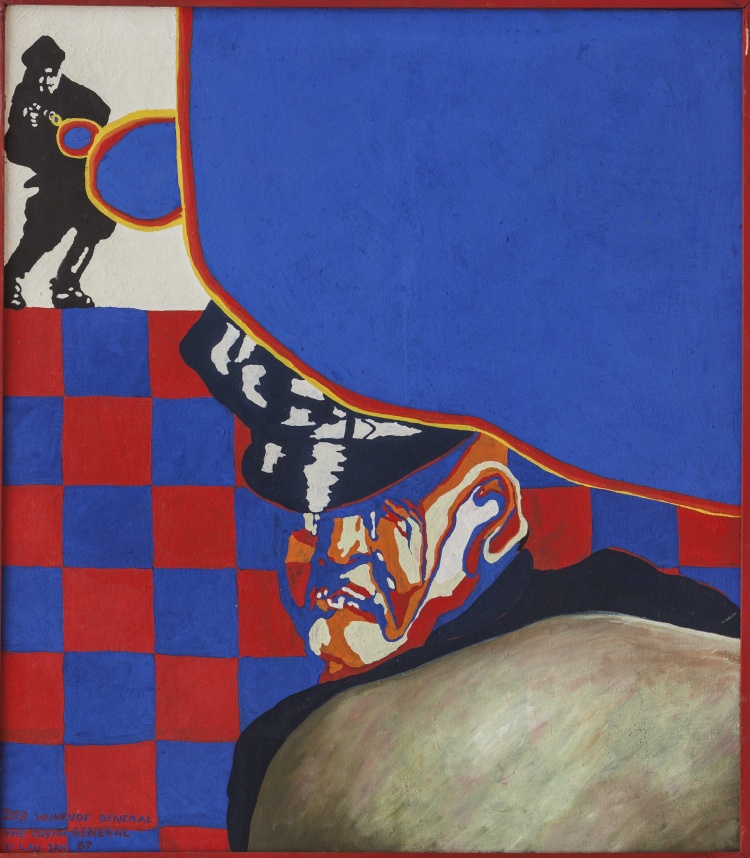UWE LAUSEN

The artistic oeuvre of Uwe Lausen (1941 - 1970) is inspired by various influences from widely differing art movements. While his early works echo Art Brut, the artist subsequently began to take an increasing interest in the artist movement CoBrA and the provocative art of the Vienna actionists. The sacralisation of the latter’s actions complied with non-conformist’s own outlook. Long-term companions and friends, such as Franz Böckelmann, describe Uwe Lausen as an “intellectual beast” who understood how to undermine, with his intellect, the authority of his teachers. In a generation inspired by Daniel Defoe’s Robinson Crusoe, deriving from it the anti-cannibalistic views of the good Christian, Lausen developed his very own world view. Accordingly, he refused the traditional academic training and became an autodidact. In the process he sought support from artists like HP Zimmer, member of the SPUR group, who accepted the young Lausen as an art apprentice. Through these contacts, Lausen also became part of the Situationist Internationale, until he was expelled from the movement in 1965. At which time he was already celebrated as a new star in the art world, who was presented in exhibitions together with greats such as Sigmar Polke, Georg Baselitz, or Gerhard Richter.
On the one hand, his works can be read as an artistic reaction to the political and social goings-on of his time, real events whose contradictions inspired Lausen to his paintings. On the other hand, the rooms and worlds depicted increasingly lose their relation to reality, by way of boundaries being eliminated and bottoms removed. His confrontation with the body as a deformed mass, as exemplified in his works Unbekannte Komposition, figürlich (Auge Ohr Landschaft) (around 1964) or Ohne Titel (Landschaft, Fleischerlandschaft, Fleischerlandschaften) (1964), can be traced back to his intensive preoccupation with Francis Bacon, beside Asger Jorn the only artist he quoted as a direct influence.
After developing, with works such as Geometer (December 1965), “from Pop Art towards cool realism,” as Axel Hinrich Murken described it, Lausen shortly afterwards returned to his old imagery, characterised by sharpness and brutality. The German living room, hinted at through flowery wallpapers and seating furniture, by 1967 had turned into a site of gruesome scenes, i.e. crimes, murder, rape. Political events, like the inauguration of the former NS army and navy judge Hans Filbinger as minister-president of his home state Baden-Württemberg, indicated a sort of double standards that had marked the artist’s analytical view of humans from the very start. In his works, humans are degraded into metabolic machines whose only job is to cover the basic functions, food intake and excretion. The world in which these beings move develops into an ever more open spatial construct, untouched by gravity. This supposed freedom, however, in some of his works is cast into doubt by the presence of agents or officers and military personnel, for it is they who in his pictures symbolise political and social boundaries.
Belonging to the series of Soldatenbilder (soldier pictures), as they were termed by Murken, also is the picture Jagd auf das letzte Fleisch (1967). A mercenary, painted in black and white against a coloured background, fires indiscriminately with a gun, with paintballs leaving the barrel instead of bullets. The human targets, hovering in space, evoke reminiscences of set pieces from Michelangelo’s works.
Part of his last creative phase is the portfolio of eleven screen-prints entitled Stoffwechsel (1968) in which the human figures increasingly disappear from the pictures. Centre stage is taken by pipes, tubes and chairs, depicted very boldly and overly simplified. Many elements and motifs in Lausen’s works can be explained by the hallucinogenic effect of the drugs he regularly consumed. In 1970, at the age of only 29 years, he put an end to his life, when, during an LSD trip, he cut his wrists at his parents’ house. In a mere nine years, Lausen created an extensive and above all various oeuvre which to this day is seen by a number of experts as a precursor to the wild painting later emerging. Presumably, his oeuvre was even more extensive than we know today. Around 400 works on paper, 25 prints, one object, and two plaster sculptures are regarded as lost.
Kunstraum Innsbruck & DASMAXIMUM KunstGegenwart



